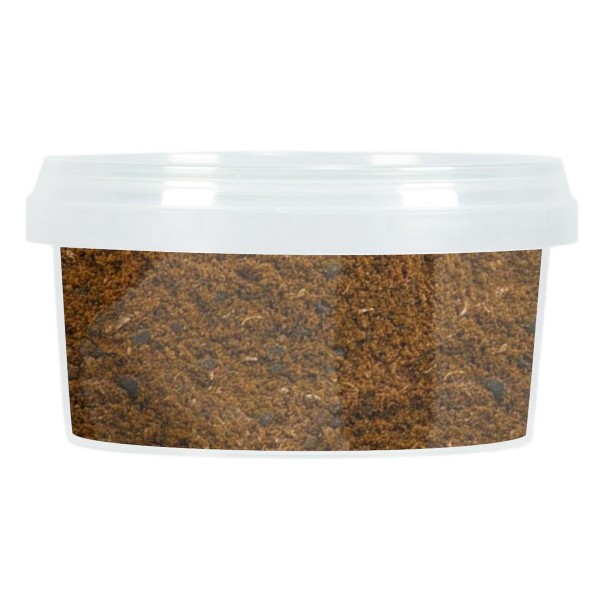This spicy blend is widely used in Middle Eastern recipes, in which baharat becomes a lively and aromatic condiment for various dishes.
A pinch of this versatile mix is enough to giving an exceptional depth of flavor to many recipes. The intense flavor is slightly sweet, not intrusive nor too spicy, with a smoky touch that makes the mixture special on meat and fish.
It is often found in dishes based on minced meat, to which it adds a peppery and earthy, with warm notes of cinnamon and cumin.
It can also be used on salted meats, as it does not contain salt, and works best with white meats and sheep from traditional Middle Eastern cuisine, such as lamb and chicken. It is also an excellent condiment for beef and fish, to which it gives an exotic touch.
Also excellent in legume soups, stews, hummus and rice. Baharat can become a substitute for garam masala for use in cooking, when choosing rice and legume recipes. Some spices contained in the mix (paprika, cumin, nutmeg and cinnamon) give a rust-colored shade, useful for spicy and colorful finishes of some recipes.
How to use Baharat in cooking
The flavor of the Lebanese mixture does not invade or cover the taste of the food, but the baharat is very aromatic, so it is better to use a small quantity.
It can be adopted this spice blend in all ground meat recipes, using 1 teaspoon for each pound of meat. It can be a full or scant teaspoon, based on taste. Baharat also works to create particular barbecue "rubs", in the rub (massage) on meat and for marinating - adding extra virgin olive oil, lemon and salt. It is also a brilliant seasoning for beef burgers, where it is useful to add ¾ of a teaspoon for every kilo of minced meat.
An excellent spicy blend also on soups, in stews, on vegetables and on seafood – for its little spiciness. You can sprinkle a pinch of baharat on the vegetables before roasting them for an extra boost of flavour. It can be combined with extra virgin olive oil to obtain a sauce useful for condiments and marinades.
For cereals it is known in rice seasoning and for Middle Eastern pita bread, in casseroles for a light smoky note. In some recipes it is also added to yogurt-based dressings and hummus – a pinch is enough.
Used as a finish for the final dressing, it gives a touch of color as well as a tantalizing flavor at the first taste.
Origins and History of the Lebanese mixture
The word Baharat derives from the Arabic “spices” and therefore represents the blend of spices par excellence, used in many Middle Eastern cuisines. Originally from North Africa, the spicy combination has also spread to Saudi Arabia and Turkey – the Turkish version contains mint.
Like all spice blends, a few main ingredients form the basis of the blend, while there are local varieties. In most cases, the spices come together to create a warm, aromatic blend, with smoky notes and little spiciness. In the version called the 7 Lebanese spices, the baharat becomes reddish, with a slightly sweetish taste.
The spices present in Baharat
We know that Baharat includes spices that can vary from region to region, but in general it is a combination of allspice, black pepper, nutmeg, cumin, coriander, paprika, cinnamon, cardamom and cloves. In our proposed Lebanese spiced blend it is enriched with kummel (caraway) and garlic.
Nutmeg gives a full aroma and a warm taste, with a citrus note that pairs well with cloves and cinnamon.
Cinnamon gives the mixture a flavor between pungent and sweetish, with an intense aroma with peppery notes.
Garlic is the element with the hot, spicy and strong flavor, which envelops the palate and gives an element of intensity to the baharat.
Coriander exhibits a sweetish aroma and flavor similar to fennel and dill; fresh and citrusy with fruity nuances.
Cardamom is famous for its balsamic, fresh smell reminiscent of honey and eucalyptus. The pungent but balanced flavor harmonizes the blend.
The allspice gives the baharat a very aromatic element, with a strong but not very spicy taste, reminiscent of cloves and some peppery notes.
Paprika gives a smoky, slightly spicy flavor with some bitter notes, which makes the mix perfect on meats.
The cloves come apartthey are tinged by the warm and strong flavour, between the slightly spicy and the sweet notes in the aftertaste, tending towards fruity. The scent adds floral hints to the mix.
Cumin has an intense and pungent but not aggressive flavour, reminiscent of fennel seeds. A warm and earthy aroma gives the blend slightly toasted notes.
Kummel (caraway Carum carvi) has a pungent and fresh flavour, similar to anise, much appreciated for flavoring bread, stewed meats and liqueurs. In Lebanese cuisine it is known as the spice of a typical rice flour pudding.
Pepper is the spiciest spice, with acrid and decisive notes; with an intense and pungent aroma, pepper creates a versatile base for seasoning many dishes.









 No reward points for this product.
No reward points for this product.
















